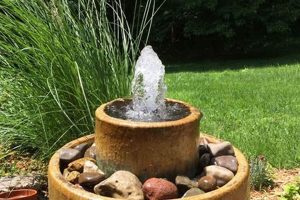The construction of outdoor recreational spaces utilizing predominantly natural materials, often undertaken by individuals or community groups, represents a growing trend in child development and landscape design. Such areas prioritize features derived from the environment, such as logs, rocks, sand, water, and vegetation, to stimulate imaginative play and physical activity. A simple example is the creation of a climbing structure from repurposed tree trunks or a sandpit bordered by natural stone.
These spaces foster a deeper connection with nature, promoting environmental awareness and stewardship from a young age. They encourage unstructured play, which is critical for cognitive development, problem-solving skills, and social interaction. The historical context of natural play areas can be traced back to adventure playgrounds that emerged in post-war Europe, emphasizing child-led design and risk assessment within a controlled environment.
The following sections will explore specific elements and practical considerations involved in planning and building such outdoor spaces, focusing on safety guidelines, material selection, and age-appropriate design principles to ensure a stimulating and enriching experience for children.
Considerations for Implementing Natural Play Spaces
The creation of enriching outdoor environments necessitates careful planning and execution. Adhering to the following guidelines will facilitate the successful development of such spaces.
Tip 1: Site Assessment: Conduct a thorough evaluation of the designated area. Identify existing natural features, assess drainage patterns, and analyze soil composition. This information informs the subsequent design and material selection processes.
Tip 2: Prioritize Safety: Implement stringent safety protocols. Ensure structures are stable and free from hazards such as sharp edges or protruding nails. Establish clear boundaries and conduct regular maintenance inspections to mitigate potential risks.
Tip 3: Utilize Sustainable Materials: Opt for locally sourced, natural, and recycled materials whenever possible. This reduces environmental impact and promotes sustainability. Examples include using reclaimed wood, river stones, and native plants.
Tip 4: Encourage Sensory Exploration: Incorporate elements that engage multiple senses. Plant fragrant herbs, construct textured pathways, and include water features to stimulate childrens curiosity and exploration.
Tip 5: Promote Imaginative Play: Design flexible spaces that can be adapted to various play scenarios. Construct tunnels, build forts, and incorporate loose parts like sticks and stones to encourage creativity and problem-solving.
Tip 6: Incorporate Native Plants: Select plant species that are indigenous to the region. Native plants require less maintenance, support local ecosystems, and provide educational opportunities for children to learn about their natural environment.
Tip 7: Establish Clear Zones: Designate specific areas for different types of play activities, such as a quiet zone for reading, an active zone for climbing, and a creative zone for building. This helps to manage traffic flow and minimize potential conflicts.
By implementing these strategies, individuals can create stimulating and secure outdoor areas that foster children’s development, enhance their connection with nature, and promote responsible environmental practices.
The subsequent discussion will focus on the integration of educational components within these natural play environments.
1. Material Sourcing
Material sourcing represents a critical facet of creating outdoor recreational spaces using natural elements. The selection and procurement of materials significantly influence the project’s cost, environmental footprint, and overall safety and aesthetic appeal.
- Local Procurement and Regional Economies
Obtaining materials from local sources minimizes transportation costs and supports regional economies. Utilizing locally sourced timber, stone, and other natural resources reduces the carbon footprint associated with long-distance transport and fosters economic development within the community.
- Recycled and Repurposed Materials
The incorporation of recycled and repurposed materials reduces waste and conserves natural resources. Examples include using reclaimed wood for construction, repurposing tires for climbing structures, and utilizing recycled plastic for edging and surfacing. This approach promotes sustainability and reduces the demand for new materials.
- Sustainable Harvesting Practices
When sourcing timber and other natural resources, it is imperative to ensure that harvesting practices are sustainable and environmentally responsible. This includes selecting wood certified by organizations like the Forest Stewardship Council (FSC), which ensures that forests are managed in an ecologically sound and socially responsible manner.
- Natural Material Durability and Longevity
The durability and longevity of natural materials should be considered when making sourcing decisions. Selecting materials that are resistant to decay, weathering, and insect damage reduces the need for frequent replacements and minimizes long-term maintenance costs. This includes selecting naturally durable wood species, using properly treated materials, and implementing appropriate construction techniques to protect against moisture and wear.
The selection of materials exerts a significant influence on the sustainability, safety, and overall value of outdoor recreational projects emphasizing natural elements. Thoughtful consideration of sourcing practices enables the creation of enriching and environmentally responsible play spaces that benefit both children and the community.
2. Safety Standards
Safety standards form an indispensable element in the creation of outdoor recreational areas, especially when undertaken through a do-it-yourself approach that utilizes natural elements. The inherent variability of natural materials introduces complexities that necessitate rigorous adherence to established safety guidelines. Failure to prioritize safety can result in preventable injuries, undermining the intended benefits of these play spaces. For instance, improperly secured climbing structures constructed from logs can pose a significant fall hazard, while untreated wood may splinter, creating laceration risks.
The application of safety standards extends beyond the selection and treatment of materials. It encompasses site assessment, design considerations, and ongoing maintenance procedures. A thorough site assessment identifies potential hazards such as uneven terrain or the presence of poisonous plants. Design considerations invol
ve adhering to recommended fall heights, ensuring adequate surfacing beneath play equipment, and providing clear pathways for circulation. Regular maintenance, including inspections for loose components, protruding nails, or decaying materials, is essential to mitigate the risk of accidents. An example of the practical application of safety standards is the use of engineered wood fiber surfacing under climbing areas to cushion falls, a practice that demonstrably reduces the severity of impact injuries.
In summary, the integration of safety standards into the development process is not merely an advisable measure but a fundamental prerequisite for ensuring the well-being of children utilizing these spaces. The proactive implementation of safety protocols, combined with diligent monitoring and maintenance, is paramount in creating outdoor environments that foster exploration and creativity without compromising user safety. Neglecting these critical aspects can lead to significant liabilities and negate the positive impacts of creating a natural play environment.
3. Ecological Integration
Ecological integration, within the context of constructing recreational environments using predominantly natural components, signifies the purposeful alignment of the play space with the surrounding ecosystem. This approach prioritizes the minimization of negative environmental impacts while maximizing benefits to local biodiversity and ecological function. It is a departure from conventional playground design that often disregards or disrupts natural processes.
- Native Plant Selection and Habitat Creation
The strategic selection of plant species indigenous to the region serves as a cornerstone of ecological integration. Native plants are adapted to local climate and soil conditions, requiring less water and maintenance while providing essential food and shelter for native wildlife. The incorporation of diverse native vegetation creates habitats for pollinators, birds, and other fauna, fostering biodiversity and ecosystem resilience. An example would be planting milkweed to support monarch butterfly populations or establishing a wildflower meadow to attract native bees.
- Water Management and Conservation
Sustainable water management practices are crucial for minimizing the environmental impact of natural recreational spaces. Implementing rainwater harvesting systems to collect water for irrigation, using permeable paving materials to reduce runoff, and designing swales to manage stormwater effectively are key components. The incorporation of water features, such as constructed wetlands or rain gardens, can further enhance water quality and provide educational opportunities. An example is a dry creek bed designed to manage stormwater runoff during periods of heavy rainfall.
- Soil Conservation and Erosion Control
Maintaining soil health and preventing erosion are vital for preserving the ecological integrity of natural environments. Implementing soil stabilization techniques, such as terracing, retaining walls constructed from natural stone, and the use of cover crops, minimizes soil loss and protects water quality. Incorporating compost and other organic matter enriches the soil, improving its water-holding capacity and supporting plant growth. An example would be the use of coir logs to stabilize slopes and prevent erosion in areas prone to runoff.
- Minimizing Artificial Materials and Waste
Reducing the reliance on synthetic materials and minimizing waste generation are essential for ecological integration. Prioritizing the use of natural materials, such as wood, stone, and natural fibers, reduces the demand for petroleum-based products and minimizes the environmental impacts associated with their production and disposal. Implementing waste reduction strategies, such as composting organic waste and recycling materials, further reduces the environmental footprint of the play space. An example is using sustainably harvested wood for play structures instead of plastic or metal.
The successful ecological integration of recreational environments not only enhances their environmental sustainability but also provides valuable educational opportunities for children to learn about nature and develop a sense of environmental stewardship. These spaces can serve as living laboratories, fostering a deeper appreciation for the interconnectedness of ecosystems and promoting responsible environmental practices.
4. Developmental Appropriateness
Developmental appropriateness is a crucial consideration in the planning and execution of outdoor recreational environments, especially when these are conceived and constructed by individuals or community groups. Play structures and spaces must align with the cognitive, physical, and social-emotional capabilities of the intended user group to maximize their benefits and minimize potential risks. Failure to consider developmental appropriateness can result in play structures that are too challenging, leading to frustration and discouragement, or conversely, too simplistic, failing to stimulate engagement and learning. For example, a climbing structure with overly large spacing between holds would be inappropriate for toddlers, increasing the risk of falls, while a simple sandbox may not offer sufficient challenge for older elementary school children.
Achieving developmental appropriateness requires a thorough understanding of child development principles. Designers must consider factors such as gross motor skills, fine motor skills, problem-solving abilities, and social interaction patterns at different age levels. This understanding informs the selection of materials, the design of play elements, and the overall layout of the play space. For instance, loose parts play, involving natural materials like sticks, stones, and pinecones, encourages creativity and problem-solving in preschool-aged children. Conversely, more complex construction activities or cooperative games may be better suited for older children. The scale of structures, the textures of surfaces, and the availability of sensory experiences must all align with the developmental needs and capabilities of the target age group. A natural playground designed with developmental appropriateness in mind fosters independence, competence, and a sense of accomplishment, ultimately promoting healthy growth and development.
In summary, prioritizing developmental appropriateness is not merely a design preference but a fundamental requirement for effective and safe recreational spaces. By integrating a comprehensive understanding of child development principles into the design and construction process, individuals and communities can create outdoor environments that stimulate learning, promote physical activity, and foster social-emotional growth. Neglecting this critical aspect can lead to underutilized or hazardous play areas, undermining the intended benefits of these spaces and potentially causing harm. Therefore, thoughtful consideration of developmental appropriateness is paramount for ensuring the success and sustainability of outdoor play environments.
5. Sustainability Practices
Sustainability practices are intrinsically linked to the concept of creating outdoor recreational spaces through do-it-yourself initiatives utilizing natural materials. The intentional integration of environmentally responsible methods directly impacts the long-term viability and ecological footprint of such projects. Actions taken during the planning, construction, and maintenance phases determine whether the play area becomes a model of environmental stewardship or a source of unintended ecological harm. For instance, selecting locally sourced, untreated timber reduces transportation emissions and avoids the introduction of harmful chemicals into the environment. Conversely, neglecting sustainable material selection can lead to deforestation or the leaching of toxins into the soil and water table.
The adoption of sustainable practices extends beyond material selection. Water conservation measures, such as rainwater harvesting for irrigating vegetation, and soil conservation techniques, like using native plants to prevent erosion, contribute to the overall ecological health of the play area. The implementation of composting systems to manage organic waste reduces landfill burden and enriches soil fertility, creating a closed-loop system that minimizes environmental impact. An example of this is incorporating a designated composting area for fallen leaves and grass clippings, which can then be used to fertilize the garden areas within the play space. This holistic approach ensures that the play area operates in harmony with its surrounding ecosystem.
In conclusion, sustainability practices are not merely an optional add-on but rather a fundamental component of creating recreational spaces utilizing natural materials. The deliberate and consistent application of environmentally responsible methods ensures that these spaces are not only enjoyable and beneficial for children but also contribute positively to the health and resilience of the environment. Ignoring these practices can result in short-term gains at the expense of long-term ecological consequences, undermining the very purpose of creating a natural play environment. Thus, prioritizing sustainability is essential for responsible and effective implementation of recreational areas designed with natural elements.
Frequently Asked Questions about DIY Natural Playgrounds
This section addresses common inquiries and misconceptions regarding the creation of outdoor recreational spaces using predominantly natural materials. The information presented aims to provide clarity and guidance for individuals and communities undertaking such projects.
Question 1: What are the primary safety considerations when constructing a natural playground?
Safety is paramount. Potential hazards include sharp edges on rocks or wood, unstable climbing structures, and poisonous plants. Thorough site assessment, appropriate material selection, adherence to recommended fall heights, and regular maintenance are essential.
Question 2: How can the environmental impact of a DIY natural playground be minimized?
Prioritize locally sourced and recycled materials. Implement water conservation measures, such as rainwater harvesting. Avoid the use of synthetic chemicals and pesticides. Select native plants that require minimal maintenance and support local ecosystems.
Question 3: What are some cost-effective materials suitable for building a natural playground?
Reclaimed wood, locally sourced stone, and recycled tires can be cost-effective options. Natural elements found on site, such as logs and branches, can also be utilized, provided they are inspected for safety.
Question 4: How can a natural playground be designed to be developmentally appropriate for different age groups?
Consider the physical and cognitive abilities of the intended users. Toddlers require simpler structures with soft surfaces, while older children can benefit from more challenging climbing elements and complex construction activities.
Question 5: What are the long-term maintenance requirements for a natural playground?
Regular inspections are crucial to identify and address potential hazards. Wood structures may require periodic treatment to prevent decay. Vegetation should be maintained to prevent overgrowth or the spread of invasive species. Surfacing materials should be replenished as needed.
Question 6: Are there any specific regulations or permits required for building a natural playground?
Local building codes and zoning regulations may apply, particularly regarding structural safety and accessibility. It is advisable to consult with local authorities to ensure compliance with all applicable requirements.
In summary, responsible planning, material selection, and maintenance are crucial for creating safe, sustainable, and developmentally appropriate play areas. Understanding the potential risks and benefits allows for informed decision-making and contributes to the success of the project.
The next section will explore case studies of successful DIY natural playgrounds, providing practical examples and lessons learned.
Conclusion
This exploration of “diy natural playground ideas” has underscored several critical considerations. The safety and developmental appropriateness of these spaces demand meticulous planning and execution. Furthermore, responsible material sourcing and adherence to sustainable practices are paramount in minimizing environmental impact. The integration of ecological principles and compliance with local regulations are also essential components.
Creating successful outdoor recreational spaces using natural elements requires a commitment to thoughtful design, ongoing maintenance, and a deep understanding of the ecological context. Failure to address these factors adequately may compromise the safety, sustainability, and overall benefit of these endeavors. Therefore, a proactive and informed approach is necessary to ensure these environments foster positive experiences and long-term environmental stewardship.







